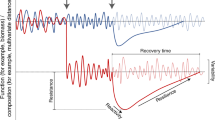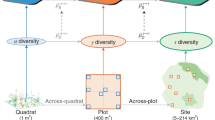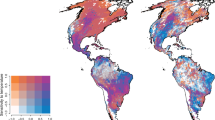Abstract
There exists little doubt that the Earth's biodiversity is declining. The Nature Conservancy, for example, has documented that one-third of the plant and animal species in the United States are now at risk of extinction. The problem is a monumental one, and forces us to consider in depth how we expect ecosystems, which ultimately are our life-support systems, to respond to reductions in diversity. This issue — commonly referred to as the diversity–stability debate — is the subject of this review, which synthesizes historical ideas with recent advances. Both theory and empirical evidence agree that we should expect declines in diversity to accelerate the simplification of ecological communities.
This is a preview of subscription content, access via your institution
Access options
Subscribe to this journal
Receive 51 print issues and online access
$199.00 per year
only $3.90 per issue
Buy this article
- Purchase on SpringerLink
- Instant access to full article PDF
Prices may be subject to local taxes which are calculated during checkout


Similar content being viewed by others
References
Riciardi, A. & Rasmussen, J. B. Extinction rates of North American freshwater fauna. Conserv. Biol. 13, 1220 –1222 (2000).
Reid, W. V. Strategies for conserving biodiversity. Environment 39, 16–43 (1997).
Levin, S. Fragile Dominion: Complexity and the Commons (Helix books, Reading, MA, 1999).
Lodge, D. Biological invasions: lessons for ecology. Trends Ecol. Evol. 8, 133–137 (1993).
Cohen, A. & Carlton, J. T. Accelerating invasion rate in a highly invaded estuary. Science 279, 555 –558 (1998).
Odum, E. P. Fundamentals of ecology (Saunders, Philadelphia, 1953 ).
Elton, C. S. Ecology of Invasions by Animals and Plants (Chapman & Hall, London, 1958).
MacArthur, R. H. Fluctuations of animal populations and a measure of community stability. Ecology 36, 533–536 ( 1955).
May, R. M. Stability and complexity in model ecosystems (Princeton Univ. Press, 1973).
Gardner, M. R. & Ashby, W. R. Connectance of large dynamic (cybernetic) systems: critical values for stability. Nature 228, 784 (1970).
Pimm, S. L. & Lawton, J. H. On feeding on more than one trophic level. Nature 275, 542– 544 (1978).
Yodzis, P. The stability of real ecosystems. Nature 289, 674–676 (1981).
Armstrong, R. A. & McGehee, R. Competitive exclusion . Am. Nat. 115, 151–170 (1980).
DeAngelis, D. & Waterhouse, J. C. Equilibrium and nonequilibrium concepts in ecological models. Ecol. Monogr. 57, 1–21 (1987).
Michalski, J. & Arditi, R. in Advances in Environmental and Ecological Modelling (ed. Weill, A.), 1–20 (Elsevier, Paris,1999).
Huisman, J. & Weissing, F. J. Biodiversity of plankton by species oscillations and chaos. Nature 402, 407–410 (1999).
McCann, K., Hastings, A. & Huxel, G. R. Weak trophic interactions and the balance of nature . Nature 395, 794–798 (1998).
Law, R., & Morton, D. Permanence and the assembly of ecological communities. Ecology 77, 762– 775 (1996).
Hastings, A. & Higgins. K. Persistence of transients in spatially structured ecological models. Science 263, 1133–1136 (1994).
Tilman, D. & Downing, J. A. Biodiversity and stability in grasslands. Nature 367, 363– 365 (1994).
Tilman, D., Wedin, D. & Knops, J. Productivity and sustainability influenced by biodiversity in grassland ecosystems. Nature 379, 718 –720 (1996).
Tilman, D. Biodiversity: population versus ecosystem stability. Ecology 77, 350–363 (1996).
Schapfer, F. & Schmid, B. Ecosystem effects of biodiversity: a classification of hypotheses and exploration of empirical results. Ecol. Applic. 9, 893–912 (1999).
Doak, D. F. et al. The statistical inevitability of stability-diversity relationships in community ecology. Am. Nat. 151, 264– 276 (1998).
Tilman, D., Lehman, C. L. & Bristow, C. E. Diversity-stability relationships: statistical inevitability or ecological consequence. Am. Nat. 151, 277–282 (1998).
Sankaran, M. & McNaughton, S. J. Determinants of biodiversity regulate compositional stability of communities. Nature 401, 691–693 (1999).
Huston, M. A. Hidden treatments in ecological experiments: re-evaluating the ecosystem function of biodiversity. Oecologia 110, 449– 460 (1997).
Tilman, D. et al. The influence of functional diversity and composition on ecosystem processes. Science 277, 1300– 1302 (1997).
Hooper, D. U. & Vitousek, P. M. The effects of plant composition and diversity on ecosystem processes. Science 277, 1302–1305 (1997).
Wardle, D. A. et al. Plant removals in perennial grassland: vegetation dynamics, decomposers, soil biodiversity, and ecosystem properties. Ecol. Monogr. 69, 535–568 ( 1999).
van der Heijden, M. et al. Mycorrhizal fungal diversity determines plant biodiversity, ecosystem variability and productivity. Nature 396, 69–72 (1998).
McNaughton, S. J. Ecology of a grazing ecosystem: the Serengeti. Ecol. Monogr. 55, 259–294 (1985).
Lawton, J. H. Ecological experiments with model systems. Science 269, 328–331 (1995).
McGrady-Steed, J., Harris, P. & Morin, P. J. Biodiversity regulates ecosystem predictability. Nature 390, 162–165 ( 1997).
McGrady-Steed, J. & Morin, P. J. Biodiversity, density compensation, and the dynamics of populations and functional groups . Ecology 81, 361–373 (2000).
Morin, P. J. & Lawler, S. P. Food web architecture and population dynamics: theory and empirical evidence. Annu. Rev. Ecol. System. 26, 505–529 ( 1995).
Naeem, S. & Li, S. Biodiversity enhances ecosystem reliability . Nature 390, 507–509 (1997).
Naeem, S. Species redundancy and ecosystem reliability. Conserv. Biol. 12, 39–45 (1998).
Lawton, J. H. & Brown, V. K. in Biodiversity and Ecosystem Function (eds Schulze, E. D. & Mooney, H. A.), 255– 270 (Springer, New York,1993).
Yachi, S. & Loreau, M. Biodiversity and ecosystem functioning in a fluctuating environment: the insurance hypothesis. Proc. Natl Acad. Sci. USA 96, 1463–1468 (1999).
Chesson, P. & Huntley, N. The roles of harsh and fluctuating conditions in the dynamics of ecological communities. Am. Nat. 150, 519–553 ( 1997).
Winemiller, K. O. Spatial and temporal variation in tropical fish trophic networks. Ecol. Monogr. 60, 331–367 (1990).
Polis, G. A. Complex trophic interactions in deserts: an empirical critique of food web theory. Am. Nat. 138, 123– 155 (1991).
Polis, G. A. & Strong, D. Food web complexity and community dynamics. Am. Nat. 147, 813– 846 (1996).
Strong, D. Are trophic cascades all wet? Differentiation and donor-control in speciose ecosystems. Ecology 73, 747– 754 (1992).
Holt, R. D. in Multitrophic interactions (eds Begon, M., Gange, A. & Brown, V.) 333–350 (Chapman & Hall, London,1996).
McCann, K. & Hastings, A. Re-evaluating the omnivory-stability relationship in food webs. Proc. R. Soc. Lond. B 264 , 1249–1254 (1997).
Huxel, G. R. & McCann, K. Food web stability: the influence of trophic flows across habitats. Am. Nat. 152, 460–469 (1998).
Post, D. M., Connors, E. & Goldberg, D. S. Prey preference by a top predator and the stability of linked food chains. Ecology 81, 8– 14 (2000).
Yodzis, P. & Innes, S. Body-size and consumer-resource dynamics . Am. Nat. 139, 1151–1175 (1992).
Chesson, J. The estimation and analysis of preference and its relationship to foraging models. Ecology 64, 1297– 1304 (1983).
Kokkoris, G. D., Troumbis, A. Y. & Lawton, J. H. Patterns of species interaction strength in assembled theoretical competition communities. Ecol. Lett. 2, 70–74 (1999).
Paine, R. T. Food-web analysis through field measurements of per capita interaction strengths . Nature 355, 73–75 (1992).
Fagan, W. F. & Hurd, L. E. Hatch density variation of a generalist arthropod predator: population consequences and community impact. Ecology 75, 2022–2032 ( 1994).
Goldwasser, L. & Roughgarden, J. Construction and analysis of a large Caribbean food web. Ecology 74, 1216–1223 (1993).
Raffaelli, D. G. & Hall, S. J. in Food Webs: Integration of Patterns & Dynamics (eds Polis, G. A. & Winemiller, K. O.) 185–191 (Chapman & Hall, New York, 1996).
Wootton, J. T. Estimates and tests of per capita interaction strength: diet abundance and impact of intertidally foraging birds. Ecol. Monogr. 67, 45–64 (1997).
Paine, R. T. Ecological determinism in the competition for space. Ecology 65, 1339–1348 (1984).
Berlow, E. Strong effects of weak interactions in ecological communities. Nature 398, 330–334 ( 1999).
Williamson, M. & Fitter, A. The varying success of invaders. Ecology 77, 1661– 1666 (1996).
Vander Zanden, M. J., Casselman, J. M. & Rasmussen, J. B. Stable isotope evidence for the food web consequences of species invasions in lakes. Nature 401, 464–467 (1999).
Fritts, T. H. & Rodda, G. H. The role of introduced species in the degradation of island ecosystems: a case history of Guam. Annu. Rev. Ecol. System. 29, 113–140 . (1998).
Reinthal, P. N. & Kling, G. W. in Theory and Application in Fish Feeding Ecology (eds Stouder, D. J., Fresh, K. L. & Feller, R.) 296–313 (Univ. South Carolina Press, 1994).
Fagan, W. F. Omnivory as a stabilizing feature of natural communities. Am. Nat. 150, 554–567 ( 1997).
de Ruiter, P. C., Neutel, A. & Moore, J. C. Energetics, patterns of interaction strengths, and stability in real ecosystems. Science 269, 1257– 1260 (1995).
Holyoak, M. & Sachdev, S. Omnivory and the stability of simple food webs. Oecologia 117, 413– 419 (1999).
Flaherty, D. Ecosystem trophic complexity and densities of the Williamette mite, Eotetranychus williamettei ewing (Acarina: Tetranychidae). Ecology 50, 911–916 (1969).
Morin, P. Productivity, intraguild predation, and population dynamics in experimental food webs. Ecology 80, 752– 760 (1999).
Luckinbill, L. S. Regulation, stability, and diversity in a model experimental microcosm. Ecology 60, 1098–1102 ( 1979).
DeAngelis, D. Dynamics of Nutrient Recycling and Food Webs (Chapman & Hall, New York, 1992).
Andersen, T. Pelagic Nutrient Cycles: Herbivores as Sources and Sinks (Springer, New York, 1997).
Elser, J. J. & Urabe, J. The stoichiometry of consumer-driven nutrient recycling: theory, observations and consequences. Ecology 80, 735–751 ( 1999).
Harding, S. P. Food web complexity enhances community stability and climate regulation in a geophysiological model. Tellus 51B, 815 –829 (1999).
Acknowledgements
This paper benefited from comments by D. Raffaelli. I also thank J. Rasmussen and P. Yodzis for conversations on this issue, and D. Kramer for providing a single comment that led me to a different viewpoint.
Author information
Authors and Affiliations
Rights and permissions
About this article
Cite this article
McCann, K. The diversity–stability debate. Nature 405, 228–233 (2000). https://doi.org/10.1038/35012234
Issue Date:
DOI: https://doi.org/10.1038/35012234



